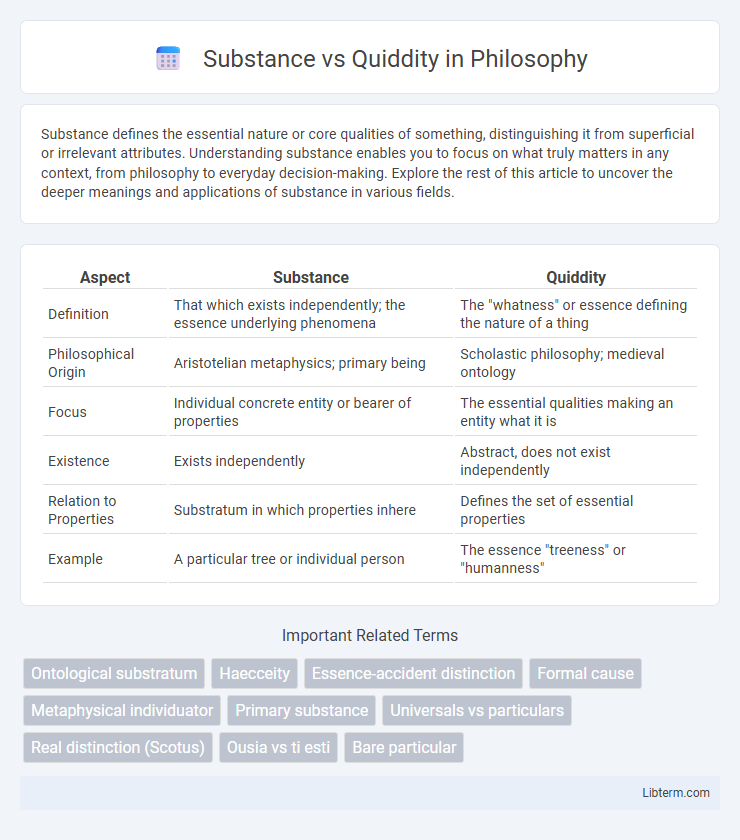Substance defines the essential nature or core qualities of something, distinguishing it from superficial or irrelevant attributes. Understanding substance enables you to focus on what truly matters in any context, from philosophy to everyday decision-making. Explore the rest of this article to uncover the deeper meanings and applications of substance in various fields.
Table of Comparison
| Aspect | Substance | Quiddity |
|---|---|---|
| Definition | That which exists independently; the essence underlying phenomena | The "whatness" or essence defining the nature of a thing |
| Philosophical Origin | Aristotelian metaphysics; primary being | Scholastic philosophy; medieval ontology |
| Focus | Individual concrete entity or bearer of properties | The essential qualities making an entity what it is |
| Existence | Exists independently | Abstract, does not exist independently |
| Relation to Properties | Substratum in which properties inhere | Defines the set of essential properties |
| Example | A particular tree or individual person | The essence "treeness" or "humanness" |
Understanding Substance: The Foundation of Being
Substance represents the fundamental reality that underlies and sustains all existence, serving as the essential "stuff" from which things are made. It provides the core identity and continuity of an entity, independent of its accidental properties or changes. Understanding substance is key to grasping the nature of being, as it anchors the existence of objects beyond mere appearances or qualities.
Defining Quiddity: Whatness and Essence Explained
Quiddity refers to the "whatness" or essence of a thing, defining its fundamental nature that distinguishes it from others. It captures the core attributes or properties that make a substance what it intrinsically is, independent of accidental features or external conditions. Understanding quiddity involves grasping the essential characteristics that constitute an entity's identity at its deepest conceptual level.
Historical Perspectives: Substance and Quiddity in Philosophy
Substance and quiddity have been central concepts in the history of philosophy, with substance often defined as the underlying reality that supports attributes, while quiddity refers to the essence or "whatness" of a thing. Aristotle distinguished substance as individual entities that exist independently, whereas quiddity is the intrinsic nature that makes an object what it is. Throughout medieval philosophy, scholastics like Thomas Aquinas further developed these ideas, linking substance to existence and quiddity to the definition or form of an object.
Substance in Metaphysics: Key Theories and Debates
Substance in metaphysics refers to the fundamental entity that exists independently and underlies properties and changes, serving as the primary bearer of attributes. Key theories include Aristotle's notion of substance as a combination of matter and form, and Locke's view of substance as a substratum supporting qualities without itself being perceivable. Debates revolve around whether substance is a concrete entity or a mere logical construct, with contemporary discussions examining its ontological status and role in grounding identity and persistence.
The Role of Quiddity: Capturing the Nature of Things
Quiddity captures the essential nature or "whatness" of an entity, distinguishing it from mere substance, which refers to the underlying existence. By defining the inherent characteristics that make a thing uniquely what it is, quiddity plays a critical role in metaphysical analysis and ontology. Understanding quiddity allows philosophers to identify the core essence that persists despite changes in substance or accidental properties.
Substance vs Quiddity: Core Differences Unveiled
Substance represents the fundamental reality or essence that underlies and persists through change, while quiddity refers to the inherent nature or "whatness" that defines a thing's identity. Substance is often considered the concrete existence that supports properties, whereas quiddity highlights the essential qualities distinguishing one entity from another. Understanding these core differences clarifies metaphysical discussions about existence, identity, and the nature of reality.
Substance and Quiddity in Scholastic Thought
In Scholastic thought, substance refers to the fundamental reality that exists independently and underlies all properties, while quiddity denotes the essence or "whatness" that defines the nature of a thing. Substance is considered the primary being that supports accidents, whereas quiddity is the conceptual definition distinguishing one substance from another. The distinction between substance and quiddity is central to medieval metaphysics, as it addresses how entities are individuated and categorized within Aristotle's framework adopted by Scholastic philosophers like Thomas Aquinas.
Modern Interpretations: Relevance Today
Modern interpretations of substance emphasize its role as the underlying reality that persists through change, while quiddity defines the essence or whatness that makes a thing uniquely itself. Contemporary philosophy explores substance in relation to identity theory and metaphysical grounding, highlighting debates on whether substances exist independently or are constituted by properties. Quiddity remains central in discussions on ontological categories and conceptual analysis, shaping inquiries into the nature of existence and meaning in analytical metaphysics.
Applications in Ontology and Epistemology
Substance denotes the fundamental reality underlying properties, serving as the core entity in ontological frameworks that define existence, while quiddity captures the essence or "whatness" that distinguishes one substance from another. In ontology, substance provides the basis for categorizing beings, whereas quiddity aids in understanding the necessary and sufficient attributes that define an entity's identity. Epistemologically, analyzing quiddity helps clarify the nature of concepts and knowledge by isolating essential characteristics, whereas substance grounds the possibility of knowledge by positing enduring entities behind changeable phenomena.
Conclusion: Bridging Substance and Quiddity
Bridging substance and quiddity reveals a profound connection between the essence and the concrete existence of entities, emphasizing that substance forms the underlying reality while quiddity expresses their defining characteristics. This integration enhances metaphysical understanding by showing that neither substance nor quiddity alone fully captures an entity's identity. Recognizing their interplay supports a more comprehensive approach to ontology, where essence and existence coexist in a unified framework.
Substance Infographic

 libterm.com
libterm.com